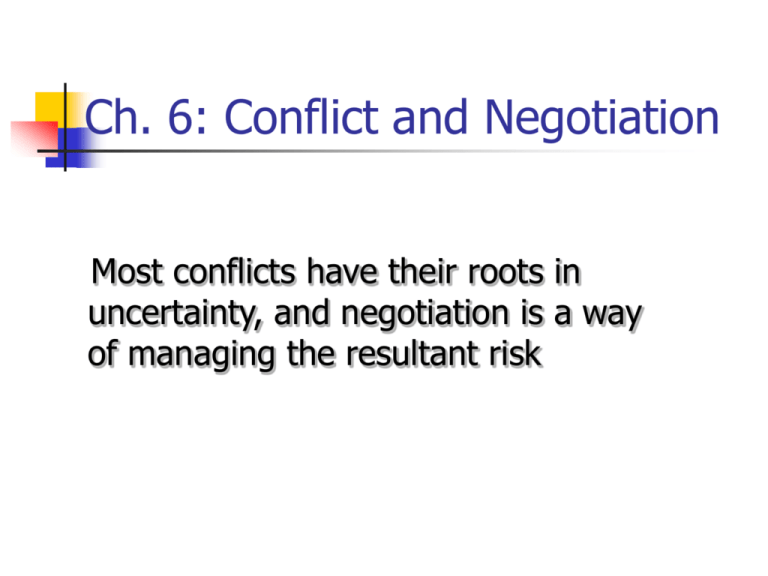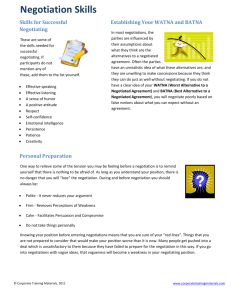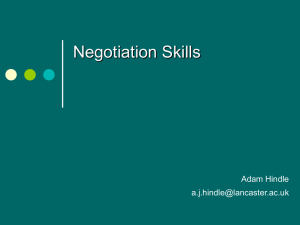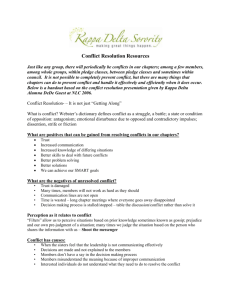Ch 2: Project Selection
advertisement

Ch. 6: Conflict and Negotiation Most conflicts have their roots in uncertainty, and negotiation is a way of managing the resultant risk Ch. 6.0: A Good Way to Understand Conflict Conflict is a process which begins when one party perceives that the other party has frustrated some concern of his/her Ch. 6.0: When Is a Conflict Resolved? When the level of frustration has been lowered to the point where no action against the other party is being contemplated Ch. 6.1: Two Definitions of Negotiation Negotiation is a process through which the parties seek an acceptable rate of exchange for items they own or control Negotiation is an endeavor that focuses on gaining the favor of people from whom we want things Ch. 6.1: Pareto-optimal Solution A solution, such that no party can be made better without making another party worse off by the same amount or more (the antithesis of a win/win situation) Ch. 6.2: Partnering Partnering is a method of transforming contractual relationships into a cohesive, cooperative project team with a single set of goals Ch. 6.2: Multi-step Process for Building Partnered Projects Commitment Four part agreement: Joint progress evaluation Problem resolution method Continuous improvement goals Joint review at project termination Ch. 6.2: Project Charter Written agreement between PM, senior management and functional managers, committing resources and people to the project Ch. 6.2: A Charter Is a Signed Commitment To: Meet design intent Complete contract without the need for litigation Finish the project on schedule Keep cost growth equal or below a predetermined amount Ch. 6.2: Scope Changes Are Caused By: Technological uncertainty When the project team learns more about the nature of the deliverable A mandate Ch. 6.2: Conflicting Priorities High priority projects: currently supported by senior management Lower priority projects: should be done if time and resources permit Mandates: must be done immediately Ch. 6.3: Conflict Sources Schedules Priorities Staff and labor requirement Technical factors Administrative procedures Cost estimate Personality conflicts Ch. 6.3: The Three Fundamental Conflict Categories Different groups with different goals Who makes decisions Interpersonal conflicts Ch. 6.3: Conflict and the Project Life Cycle (PLC) The project life cycle (PLC) Nature of conflicts in the PLC Linkage of PLC with conflict categories Ch. 6.3: Four Phases of Project Life Cycle As Seen By: Phase Senior Management Thambain and Wilemon Adams and Barndt I Bootleg work Concept II Project formation Buildup Aggregation of resources Lions share of Main program work Products to client Phase out III IV Plan Execute Terminate Ch. 6.3: Personality Clashes Senior Management PM Client Ch. 6.3: Project Manager Vs. Functional Manager Conflicts PM concern: project FM concern: day-to-day operations Ch. 6.3: Who Decides in a Matrix Organization? PM: schedule and flow of work FM: technical decisions, manpower Ch. 6.3: When Top Management Fixes Time and Cost Too Tightly 1. Underestimation of cost and time 2. PM tries to pass cost and time squeeze on to FM 3. FM complains to senior management that he/she cannot meet cost and time goals Ch. 6.3: Whose Priorities are Ruling? Functional manager Client Project team Ch. 6.3 Methods for Settling Project Priority Conflicts 1. Priority ranking through PS model 2. Priority ranking through senior management Ch. 6.3: The“Who” and “What” of Matrix Organization Conflicts Who What Project team and client Technical problems Senior Management (*) a) Wants PM to create communication rules b) Wants to dictate who reports to whom (*) Good example of senior management wanting to have their cake AND eat it! Ch. 6.3: Conflicts in the Different Phases of the PLC Phase Conflict Source Formation Confusion of setting up project Buildup Main Priorities, schedules and administrative procedures PERT critical path Phase-out Schedules, cost overrun Ch. 6.3: Fundamental Issues for Conflict during Project Formation 1. 2. 3. 4. Technical objectives Commitment of resources Priority Organizational structure Ch. 6.3: Questions Leading to Conflict during Project Formation Which of the functional areas will be needed to accomplish project tasks? What will be the required level of involvement of each of the functional areas? How will conflicts over resources/facility usage between this and other projects be settled? Ch. 6.3: More Questions Leading to Conflict during Project Formation What about those resource/facility issues between the project and the routine work in the functional departments? Who has the authority to decide the technical, scheduling, personnel and cost issues? How will changes in the parent organization’s priorities be communicated to everyone involved? Ch. 6.3: Who Will Win the Argument? Relative strength of manager PM FM Project oriented Matrix Functional Type of organization Ch. 6.3: The “Height” of Conflict during Project Buildup Issue Rivals Technical approach PM Vs. FM Handicap PM: generalist, but occasionally has a bright technical idea FM: has generally more technical expertise Ch. 6.3: How a Main Phase Scheduling Conflict Develops 1) Some project activity runs into trouble 2) Some tasks dependent on (1) will be delayed 3) (2) will delay the entire project 4) PM tries to prevent (3) from happening by requesting resources from the FM 5) PM vs. FM Ch. 6.3:Environment for Conflict during Phaseout Schedule slippage consequences from main phase felt strongly during phase out Firm deadlines hectic environment Substantial cost overruns ignored to meet deadline potential conflict with senior management Functional groups needed to support project team to meet deadlines potential conflict with FM Ch. 6.3: Personality Conflicts During Project Phaseout Pressure to complete project Anxiety to leave project Distribution of project resources at project termination Fresh starting projects Vs. Phasing out projects Ch. 6.3: Discipline Oriented Vs. Problem Oriented Individual “He/she will do whatever he/she thinks is right to get his/her own job done, whether or not it is good for the company or anyone else” Pelled and Adler, 1994 Ch. 6.3: Successful Handling of Conflicts by PM Ability to reduce and resolve conflict in ways to support achievement of project’s goals Primary tool: Negotiation Ch. 6.3: Preview and Reading for Ch. 6.4 Similarities between the confrontation-problem solving technique and win-win negotiation: Pinto and Kharbanda (1995) – conflict resolution in the spirit of win-win negotiation Dyer (1987) – focus on conflict between team members Afzalur (1992) – general work on win-win negotiating Ch. 6.4 Negotiations NOT covered in Section 6.4 President and Congress NFL player’s agent and team Real-estate buyer and seller Divorce Collective bargaining agreement Tourist and peddler Ch. 6.4: Key to Understanding the Nature of Negotiating NOT: whether or not a task will be undertaken or a deliverable produced BUT: project design of the deliverable and/or how the design will be achieved, by whom, and at what cost Ch. 6.4: Main Requirement for Conflict Reduction/Resolution Conflict is to be settled without irreparable harm to the project’s objectives Ch. 6.4: Second Requirement for Conflict Reduction/Resolution Honesty between negotiators Ch. 6.4: The Win/Win Solution Seek solutions to the conflict that not only satisfy an individual’s own needs, but also satisfy the needs of other parties-at-interest and the parent organization Ch. 6.4: Principled Negotiation 1. Separate people from problem 2. Focus on interests, not positions 3. Before trying to reach agreement, invent options for mutual gain 4. Insist on using objective criteria Ch. 6.4: How to Separate People from Problems Carefully define the substantive problem Then, let everyone work on the problem – not on the person Ch. 6.4: How to Focus on Interest, not Position WRONG: Focus on position PM: “I need this subassembly by November 15” FM:” I can’t deliver it before February 1 next year” RIGHT: Focus on interest FM and PM: “Let’s talk about the schedule for this subassembly.” Ch. 6.4: Two Examples of Negotiating Positions 1. Real estate bidder, assuming a future property value: “I will not pay more than 1 million for that property.” 2. Assume that a workgroup’s current workload will not change, PM states: “We cannot deliver this subassembly before February 1.” Ch. 6.4: Shifting Focus from Position to Interest Real estate bidders true interest: Earn a certain return on investment in the property Workgroup PM’s true interest: Not to commit to delivery of work if delivery on the due date cannot be guaranteed Ch. 6.4: An Interest Negotiator’s Knowledge and Purpose Knowledge: The parties-at-interest’s interests Purpose: Suggesting solutions that satisfy the conflicting party’s interests without agreeing with either side’s position Ch. 6.4: Before Reaching Agreement, Invent Options for Mutual Gain Marital conflict: Joe wants to go to the mountains Sue wants to go to the shore WIN/WIN solution: Go to lake Tahoe Ch. 6.4: Four Steps to Move from Parties-at-Conflict to Win/Win 1. Parties-at-conflict (pac) enter negotiations knowing what they want 2. The negotiator spells out the “substantive problem” 3. As the negotiator presents a variety of possible solutions that advance their mutual interests, the pac’s converge in their positions 4. A win/win situation emerges Ch. 6.4: Key to Finding a Negotiator’s Interests and Concerns Ask “WHY?” when he or she states a position Ch. 6.4: Insist on Using Objective Criteria Instead of bargaining on positions, try to find a standard Example: Our friend, the FM, wants to use an expensive process to test a part The cost conscious PM then asks if there is not a less expensive test to achieve the same result Ch. 6.4: Short Bibliography on Negotiating for the PM Wall, J.A., jr. “Negotiation: Theory and Practice” Glenview, Il. Scott, Foresman, 1985 – Excellent academic treatment of the subject Fisher, R., and Ury, W. “Getting to Yes” Harmondsworth, Middlesex, G.B.: Penguin Books, 1983 – clear presentation of principled negotiations Cohen, H. “You Can Negotiate Anything” Secaucus, N.J.: Lyle Stuart Inc., 1980 – outstanding guide to win-win negotiation Ch. 6.4: Tactical Issues Covered by Most Books on Negotiations What to do if you want “win-win” but the other party wants “win-lose” What to do if the other party is seating you so that bright lights shine into your eyes What to do if the other party drags their feet so as to put you into a situation of extreme time pressure to accept whatever solution they offer (continued on next slide) Ch. 6.4: Tactical Issues ….. (continued) How to settle purely technical disputes How to handle threats The FM tries to go over your head and attempts to enlist the aid of your boss to get you to accept an unsatisfactory solution How to deal with a person that dislikes you







